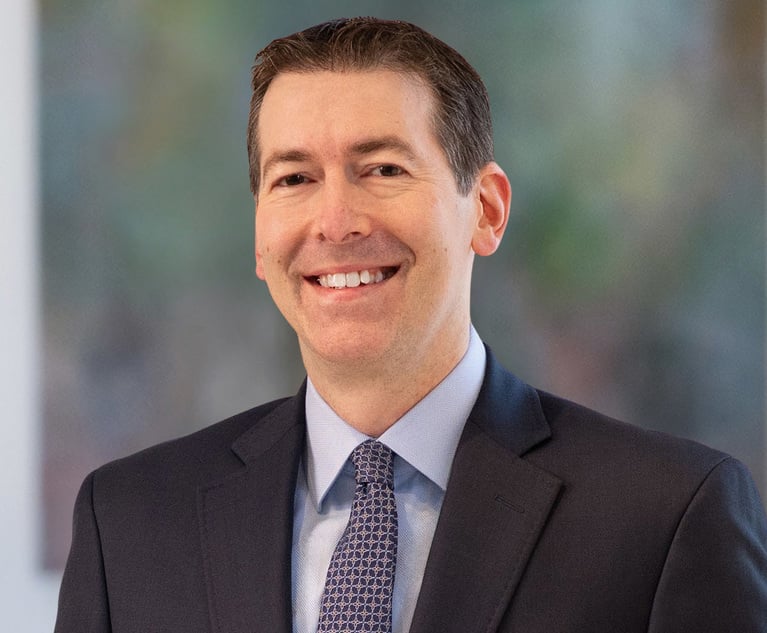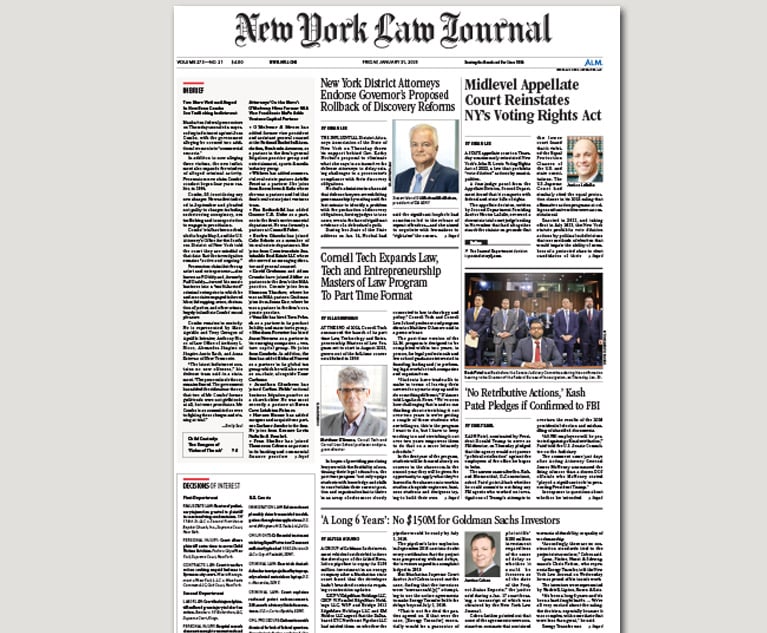Phillips Nizer Adds Data Technology and Cybersecurity Practice Head in New York
Patrick Burke returns to private practice after overseeing New York State's cybersecurity and virtual currency regulations for much of the financial services sector.
January 18, 2019 at 04:29 PM
2 minute read
 Patrick Burke, a partner at Phillips Nizer/courtesy photo
Patrick Burke, a partner at Phillips Nizer/courtesy photo
Phillips Nizer has hired Patrick Burke, founder and former deputy superintendent of the Office of Financial Innovation in the New York State Department of Financial Services, as a partner and head of the firm's data technology and cybersecurity practice.
“As the regulator in charge of oversight of New York State's cybersecurity and virtual currency regulations for much of the financial services sector, Patrick is a unique leader in the data technology and security fields,” Marc Landis, managing partner of Phillips Nizer, said in a statement.
Burke has also practiced in the New York offices of Linklaters, Reed Smith, Seyfarth Shaw, and Bennett & Samios, and has held in-house counsel roles at technology firms nMatrix and Guidance Software. He has taught extensively in the fields of computer forensics, e-discovery, and information governance at the Benjamin N. Cardozo School of Law.
During his time with New York's DFS, Burke oversaw cybersecurity examinations administered to registrants and implemented rules and regulations pertaining to virtual currency.
“At the DFS, I supervised a program where we sent teams into banks and insurance companies to see whether their protocols were up to snuff and in compliance with New York State cybersecurity regulation,” Burke said. “I got to look at a lot of different entities and assess how they were doing and whether they were improving their systems and procedures or not.”
Burke said corporations, funds, and financial institutions have a growing need for increasingly specialized legal services as some states and jurisdictions become more vigilant—and stringent—with regard to data protection and cybersecurity regulations. For example, California is highly regulated, particularly when it comes to consumer data privacy.
In addition, the danger of hacking is particularly acute because so many corporations and financial institutions still rely on information systems designed and assembled two or three decades ago, making them ripe targets for hackers looking to steal data, Burke said.
“The information systems put together 20 or 30 years ago weren't built for security. Now we're patching it all up, but it takes a lot to protect the data, both from the point of view of data storage and teaching employees not to click on certain links and be phished,” he said.
This content has been archived. It is available through our partners, LexisNexis® and Bloomberg Law.
To view this content, please continue to their sites.
Not a Lexis Subscriber?
Subscribe Now
Not a Bloomberg Law Subscriber?
Subscribe Now
NOT FOR REPRINT
© 2025 ALM Global, LLC, All Rights Reserved. Request academic re-use from www.copyright.com. All other uses, submit a request to [email protected]. For more information visit Asset & Logo Licensing.
You Might Like
View All
Orrick Hires Longtime Weil Partner as New Head of Antitrust Litigation

Profits Surge Across Big Law Tiers, but Am Law 50 Segmentation Accelerates
4 minute readTrending Stories
- 1Bass Berry & Sims Relocates to Nashville Office Designed to Encourage Collaboration, Inclusion
- 2Legaltech Rundown: McDermott Will & Emery Invests $10 Million in The LegalTech Fund, LexisNexis Releases Conversational Search for Nexis+ AI, and More
- 3The TikTokification of the Courtroom
- 4New Jersey’s Arbitration Appeal Deadline—A Call for Clarity
- 5Law Firms Look to Gen Z for AI Skills, as 'Data Becomes the Oil of Legal'
Who Got The Work
J. Brugh Lower of Gibbons has entered an appearance for industrial equipment supplier Devco Corporation in a pending trademark infringement lawsuit. The suit, accusing the defendant of selling knock-off Graco products, was filed Dec. 18 in New Jersey District Court by Rivkin Radler on behalf of Graco Inc. and Graco Minnesota. The case, assigned to U.S. District Judge Zahid N. Quraishi, is 3:24-cv-11294, Graco Inc. et al v. Devco Corporation.
Who Got The Work
Rebecca Maller-Stein and Kent A. Yalowitz of Arnold & Porter Kaye Scholer have entered their appearances for Hanaco Venture Capital and its executives, Lior Prosor and David Frankel, in a pending securities lawsuit. The action, filed on Dec. 24 in New York Southern District Court by Zell, Aron & Co. on behalf of Goldeneye Advisors, accuses the defendants of negligently and fraudulently managing the plaintiff's $1 million investment. The case, assigned to U.S. District Judge Vernon S. Broderick, is 1:24-cv-09918, Goldeneye Advisors, LLC v. Hanaco Venture Capital, Ltd. et al.
Who Got The Work
Attorneys from A&O Shearman has stepped in as defense counsel for Toronto-Dominion Bank and other defendants in a pending securities class action. The suit, filed Dec. 11 in New York Southern District Court by Bleichmar Fonti & Auld, accuses the defendants of concealing the bank's 'pervasive' deficiencies in regards to its compliance with the Bank Secrecy Act and the quality of its anti-money laundering controls. The case, assigned to U.S. District Judge Arun Subramanian, is 1:24-cv-09445, Gonzalez v. The Toronto-Dominion Bank et al.
Who Got The Work
Crown Castle International, a Pennsylvania company providing shared communications infrastructure, has turned to Luke D. Wolf of Gordon Rees Scully Mansukhani to fend off a pending breach-of-contract lawsuit. The court action, filed Nov. 25 in Michigan Eastern District Court by Hooper Hathaway PC on behalf of The Town Residences LLC, accuses Crown Castle of failing to transfer approximately $30,000 in utility payments from T-Mobile in breach of a roof-top lease and assignment agreement. The case, assigned to U.S. District Judge Susan K. Declercq, is 2:24-cv-13131, The Town Residences LLC v. T-Mobile US, Inc. et al.
Who Got The Work
Wilfred P. Coronato and Daniel M. Schwartz of McCarter & English have stepped in as defense counsel to Electrolux Home Products Inc. in a pending product liability lawsuit. The court action, filed Nov. 26 in New York Eastern District Court by Poulos Lopiccolo PC and Nagel Rice LLP on behalf of David Stern, alleges that the defendant's refrigerators’ drawers and shelving repeatedly break and fall apart within months after purchase. The case, assigned to U.S. District Judge Joan M. Azrack, is 2:24-cv-08204, Stern v. Electrolux Home Products, Inc.
Featured Firms
Law Offices of Gary Martin Hays & Associates, P.C.
(470) 294-1674
Law Offices of Mark E. Salomone
(857) 444-6468
Smith & Hassler
(713) 739-1250








